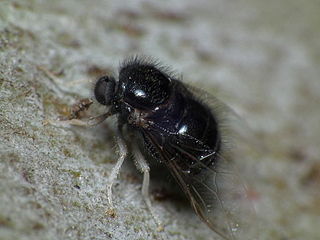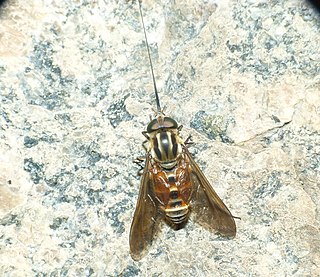
Silvius is a genus of flies in the family Tabanidae.

Superfamily Tabanoidea are insects in the order Diptera.

Haematopota is a genus of flies in the horse-fly family, Tabanidae. Among the horse-flies, they are most commonly known as clegs. Many species have colorful, sinuously patterned eyes in life, a character that fades after death. The wings are typically patterned with spots of grey. The genus is named from the Ancient Greek for blood-drinker: αἷμα, haîma, blood; πότης, pótës, drinker. Some species are known to be vectors of livestock diseases.

Stratiomys is a genus of flies in the family Stratiomyidae.

Panopinae is a subfamily of small-headed flies (Acroceridae). Their larvae are endoparasites of spiders in the infraorder Mygalomorphae.

Dichelacera is a genus of horse flies in the family Tabanidae.

Tabaninae is a subfamily in the family Tabanidae commonly known as horse flies. There are more than 3000 described species in Tabaninae.

Chrysopsinae is an insect subfamily in the family Tabanidae commonly known as deer flies or sheep flies and are bloodsucking insects considered pests to humans and cattle. They are large flies with large brightly-coloured compound eyes, and large clear wings with dark bands. They are larger than the common housefly and smaller than the horse-fly.

Pterodontia is a genus of small-headed flies. There are at least 20 described species in Pterodontia.
Pterodontia flavipes is a species of small-headed flies. Adult males are 5.5–10.5 mm in size, while adult females are 5–9 mm. The larvae are thought to enter their host spiders at the leg articulations. First instar larvae of the species have also been recorded attacking the mites Podothrombium and Abrolophus.

Philoliche is a genus of long-tongued Horse-flies found in the Old World. It appears to be the sole member of tribe Philolichini.

Dasyrhamphis is a species of 'horse fly' belonging to the family Tabanidae subfamily Tabaninae.

Pangoniinae is a subfamily of horse-flies in the order Diptera, containing at seven tribes and over 40 genera.
Longina is a genus of flies in the family Neriidae.
Lepiselaga is a genus of horse flies in the family Tabanidae.
Bouvieromyiini is a tribe of horse flies in the family Tabanidae.
Rhigioglossa is a genus of horse flies in the family Tabanidae.
Acanthocera longicornis is a species of horse flies in the family Tabanidae.












